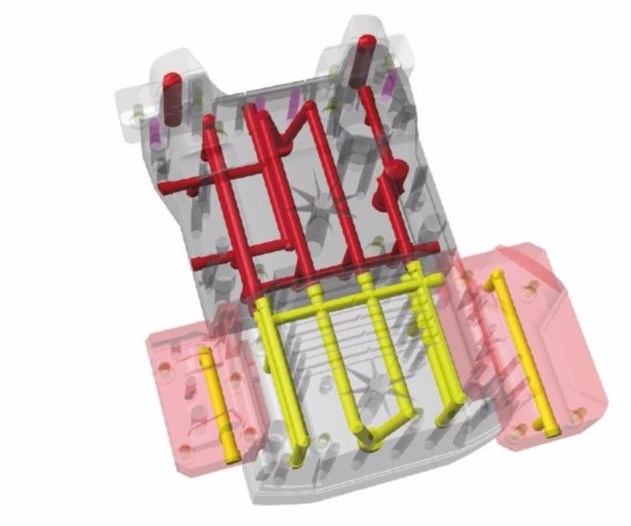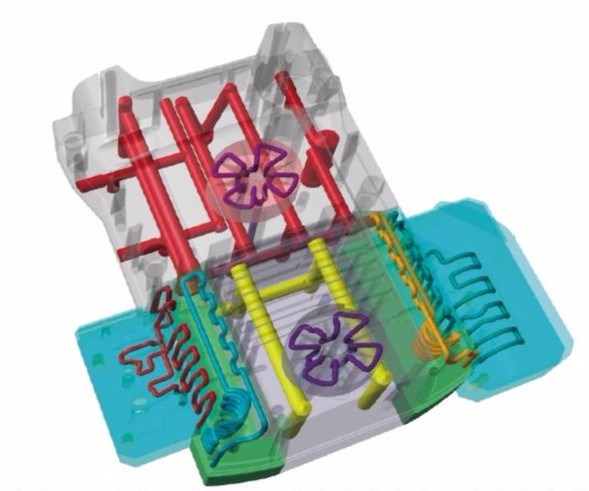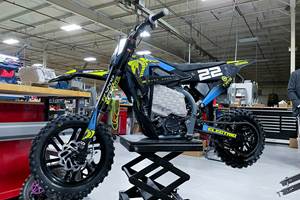Conformally Cooled Injection Mold Reduces Cooling Time by 55 Percent
With Renishaw’s help, Kärcher ended its production bottleneck using 3D-printed molds with conformal cooling channels.
Share
Alfred Kärcher GmbH & Co. KG sells millions of its K2 high-pressure washers worldwide every year. Producing enough units to meet this global demand, however, is not without its challenges, and the washer’s signature bright yellow casing had become a production bottleneck that restricted the number of units the company could manufacture. To address this problem, the company turned to Renishaw-owned LBC Engineering, which used additive manufacturing (AM) techniques to produce a mold with complex cooling channels. Using this new mold, Kärcher was able to drastically decrease the molding process’s cooling time, meeting the factory’s production goals.
As Kärcher products have grown in popularity worldwide, the German manufacturer has tried to keep pace with global demand. The company produces its signature yellow plastic casing for the K2 series washer on six injection molding machines, each capable of molding 1,496 casings every day, for a total of 8,976 casings daily. The four assembly lines, however, have a production capacity of 12,000 K2 washers every day, exceeding the capabilities of the molding process.
Researching the Problem
To meet the capacity of its production line, the company needed to increase the number of casings it produced. Rather than purchasing more molding machines, Leopold Hoffer, coordinator for injection molding at Kärcher, believed that improving the process could increase the productivity of the existing machines. “Our aim was to reduce cycle time from the original 52 seconds to between 40 and 42 seconds,” Hoffer says. To accomplish this, the company turned to LBC Engineering, part of Renishaw GmbH.
The Renishaw engineering group started by collecting data on the molding process, using thermographic images provided by Kärcher to simulate the existing mold using Cadmould 3D-F software. The simulation revealed that cooling accounted for 22 seconds of the 52-second cycle time, with melting at 220°C and de-molding at 100°C. The simulation identified hot spots responsible for much of the length of the cooling time, and the Renishaw engineers determined that traditional cooling systems, drilled in straight lines, would not be enough to deal with these hot spots. Instead, the company turned to metal additive manufacturing to build conformal cooling channels directly into the mold.
A Conformal Solution
Renishaw proposed a modified mold design featuring two 3D-printed cores to provide conformal cooling at the identified hotspots. Simulations showed that the 3D-printed conformal cooling channels would reduce wall temperature in the molds by 40°C to 70°C, shortening cycle time by 22 to 10 seconds, a 55 percent reduction.
Kärcher confirmed these results and implemented the new molds into its production line in conjunction with some adjustments to peripheral components such as the material feed and handling system. As a result, cycle time has dropped from 52 to 37 seconds, with the lion’s share of that reduction provided by the shortened cooling time. This reduced cycle time has increased the number of K2 casings a single molding system could produce, a jump from 1,496 to 2,101. Between six molding machines, this increase more than met the goal of 12,000 units produced every day.
Though he had been skeptical of the project, Hoffer was pleased. “At the end of the day, the results were better than expected,” he says. “Renishaw sold us a complete improvement package with a holistic consideration and analysis of the mold used to achieve the best results. In our case, this meant a mix of conventional cooling technology, project-specific cores produced using additive manufacturing, and vacuum-brazed cores.”
With the improvements to the cooling system enabling the full utilization of the assembly lines, Hoffer has realized the importance of cooling considerations. “In the future,” he says, “we will give more attention to cooling in the design phase. Cooling calculations will be an essential stage of each mold design at Kärcher.”
Related Content
DMG MORI: Build Plate “Pucks” Cut Postprocessing Time by 80%
For spinal implants and other small 3D printed parts made through laser powder bed fusion, separate clampable units resting within the build plate provide for easy transfer to a CNC lathe.
Read MoreMultimaterial 3D Printing Enables Solid State Batteries
By combining different 3D printing processes and materials in a single layer, Sakuu’s Kavian platform can produce batteries for electric vehicles and other applications with twice the energy density and greater safety than traditional lithium-ion solutions.
Read MoreNew Electric Dirt Bike Is Designed for Molding, but Produced Through 3D Printing (Includes Video)
Cobra Moto’s new all-electric youth motocross bike could not wait for mold tooling. Parts have been designed so they can be molded eventually, but to get the bike to market, the production method now is additive manufacturing.
Read MoreCasting With Complexity: How Casting Plus 3D Printing Combine the Strengths of Both
Aristo Cast is advancing a mode of part production in which casting makes the part, but 3D printing enables the geometry.
Read MoreRead Next
At General Atomics, Do Unmanned Aerial Systems Reveal the Future of Aircraft Manufacturing?
The maker of the Predator and SkyGuardian remote aircraft can implement additive manufacturing more rapidly and widely than the makers of other types of planes. The role of 3D printing in current and future UAS components hints at how far AM can go to save cost and time in aircraft production and design.
Read More3D Printing Brings Sustainability, Accessibility to Glass Manufacturing
Australian startup Maple Glass Printing has developed a process for extruding glass into artwork, lab implements and architectural elements. Along the way, the company has also found more efficient ways of recycling this material.
Read More4 Ways the Education and Training Challenge Is Different for Additive Manufacturing
The advance of additive manufacturing means we need more professionals educated in AM technology.
Read More












.png;maxWidth=300;quality=90)













